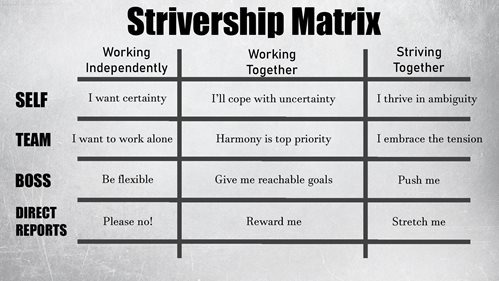
Thriving In Ambiguity: Part 5 of 5 – Lead By Being Led.
Ambiguity: Part 5 of 5 – Lead By Being Led.
As we enter yet another week of lockdowns, skyrocketing unemployment, paralyzed supply chains, and grim death counts, world leaders are considering how and when to return to business as usual. There is a growing realization, however, that “normal” has been forever changed. Globalization and the rapid advancement of technology had already forced most businesses to embrace uncertainty in ways that past generations couldn’t have imagined. But we are just now starting to understand how vulnerable our new world is to things like disease and weather phenomena. It seems like the only thing we can count on regarding the future is that we have no idea what the future will hold.
The coronavirus pandemic has stopped us in our tracks and provided us with an opportunity to reflect on how we can come out of this better than we were before. We have become accustomed to finding the path of least resistance to solve problems. If the path to a solution is unclear, we tend to avoid it altogether because venturing down a road less traveled risks damaging our personal brand. This attitude is holding us back. We live in a world of ambiguity – a world where many of the problems we face do not have solutions. Issues like climate change, a crumbling infrastructure, health care, and inequality threaten to endanger the lives of future generations. Tackling these extraordinarily complicated issues will require moving out of our comfort zones to engage in unconventional problem-solving. To thrive in ambiguity we must stop managing our brands and summon the courage to lead.
Leadership is exhibited in two ways. People who have direct reports are in a position to lead others, but everyone can lead by example. In the past 3 entries of this blog series, I have used this matrix to talk about how individual contributors – people who do not have direct reports – can lead by example by striving together in relationships to Self, Team, and Boss.
In Relationship to Self, individuals lead by example when they make a personal commitment to move out of their comfort zone and take on projects that offer no guarantee of success. They commit to tackling issues that require being in constant invent-adapt-reinvent mode.
In Relationship to Team, individuals lead by example when they assert themselves by challenging their teammates in meetings – and are willing to be challenged in return. These individuals believe that by holding back to protect their brand they would be robbing their team of learning. However, when they leave meetings, everything that happened in the meeting room stays in the meeting room and they support their teammates to everyone outside the team unconditionally – no exceptions. And if they have a problem with a teammate, they communicate with them directly.
Much like the team relationship, individuals lead by example in Relationship to Boss when they demonstrate the willingness to challenge the boss with new ideas, trust and support the boss to everyone outside the team, and communicate with them directly when a serious issue arises between them.
Unfortunately, companies with workers who are truly empowered to lead by example are extraordinarily rare today because bosses often fail to seize the opportunity to lead others, and instead choose to manage their direct reports. Managers feel threatened by the very notion of empowering the people in their charge to lead by example. In their Relationship to Direct Reports, managers primarily seek compliance. They want all ideas to flow in one direction – from the top-down.
Companies that are managed can succeed in times of incremental change. But they cannot succeed in a world of ambiguity. Managers often possess strong ego drive, but they lack empathy. Their inability (or unwillingness) to put themselves in the shoes of others creates a blind spot. They fail to see and understand the power of the human capital possessed by their direct reports.
Managers know where they want the company to go, they’re set on exactly what it’s going to look like when they get there, and they’re going to (micro) manage you every step of the way. In a world of ambiguity, where most roads are less traveled, they are lost.
Leaders, however, possess both a strong ego drive and empathy. They know where they want the company to go, but they’re not set on exactly what it’s going to look like when they get there, and they want you to lead them there. When there is no road map they thrive because they know they’re not traveling alone.
Leaders inspire and empower their direct reports to stretch beyond their perceived limitations by imbuing Strivership, an ethic of continuous improvement based on the origin of the word compete: to strive together. In essence, striving together is not about winners and losers. It’s about becoming immersed in the process of getting better by moving out of your comfort zone to wrestle with difficult problems.
Managers seek the comfort of being perceived as winners. They are desperate to compare favorably. Leaders understand that you cannot control winning, but you can control your willingness to compete – to strive together. Managers lecture their people about the importance of stretching beyond their perceived limitations. They want people to simply follow them. Leaders artfully cultivate a willingness to achieve things that seem unimaginable in their people. They seek to lead by being led.
Dwight Eisenhower was a great example of what it means to lead others in times of crisis. As Commander of the Allied forces during World War II, he understood that leaders needed to motivate their people to stretch beyond what they perceived possible. Eisenhower believed that leadership didn’t come from barking orders or mandating action. He never viewed his men as push-pins on a map. “Leadership,” he said, “is the art of getting someone else to do something you want done because he wants to do it.”
He displayed empathy for his men by refusing to set himself apart from them. At one point during the war, while on a cruise around the Isle of Capri, he learned that a large villa had been designated as his quarters. He inquired about the neighboring villa as well, and learned that it would soon belong to General Spaatz, a member of his staff. “Damn it,” he said. “That’s not my villa and that’s not General Spaatz’s villa! This is supposed to be a center for combat men, not a playground for the brass.”
Although the strength of Eisenhower’s ego drive was clearly evident through the expression of strong convictions, he understood that leadership is not about simply pushing your own ideas. He understood intuitively that leadership is the art of cultivating in your people the willingness to take on challenges that have no guarantee of success. Instead of constantly issuing orders, he circulated among his troops as often as possible asking questions, making observations, and even injecting humor.
Eisenhower’s leadership won him the national respect that propelled him to the White House. In the American people, as with his men in the Army, Eisenhower cultivated a spirit of Strivership, pushing the nation to move past its perceived limitations and to emerge on the world stage as a leader. Through the formation of NATO at the start of the Cold War, Eisenhower held firm that America should stand for its convictions the world over.
I’ve focused a lot on national leadership in this series because the pressures and uncertainty that leaders in these roles must endure are enormous. They made decisions that changed the course of history. In many ways, it feels like we are all living in such a moment now. We need leadership like never before at a time when too many people in leadership positions settle for managing expectations. Great leaders move out of their comfort zones and seek to lead by being led. By modeling vulnerability, they earn the trust of their people, and can then ask them to lead by example. And right now, whether it’s in a business being run remotely, in an emergency room, or at the supermarket checkout, we all need to lead — we all need to strive together.
Allied Partner Jeff Moore is well-kn own and highly-respected throughout college athletics – not only for what he accomplished as a coach, but also for his prowess and the tangible results he has delivered while working with teams and athletic departments. As CEO of Moore Leadership, Jeff helps leaders in both college sports and the corporate world build championship teams.
own and highly-respected throughout college athletics – not only for what he accomplished as a coach, but also for his prowess and the tangible results he has delivered while working with teams and athletic departments. As CEO of Moore Leadership, Jeff helps leaders in both college sports and the corporate world build championship teams.



